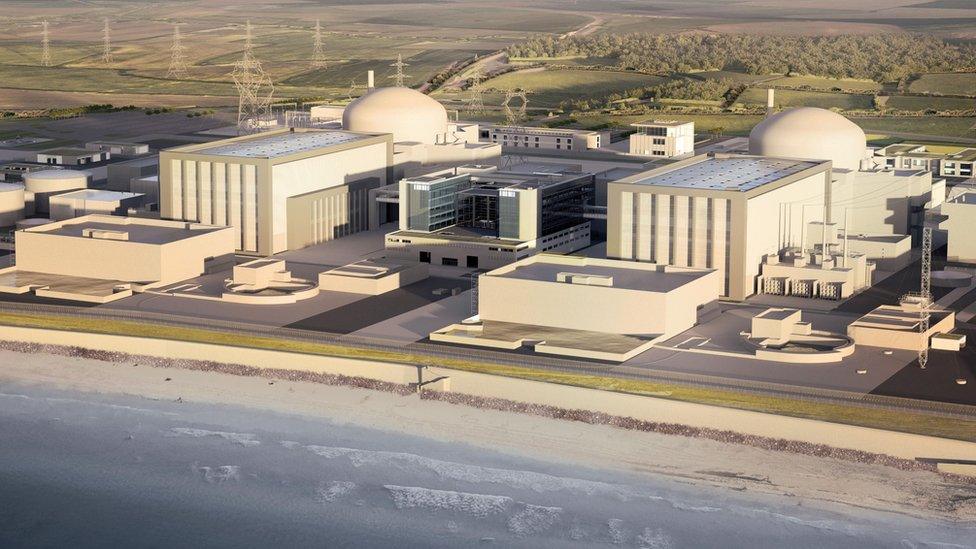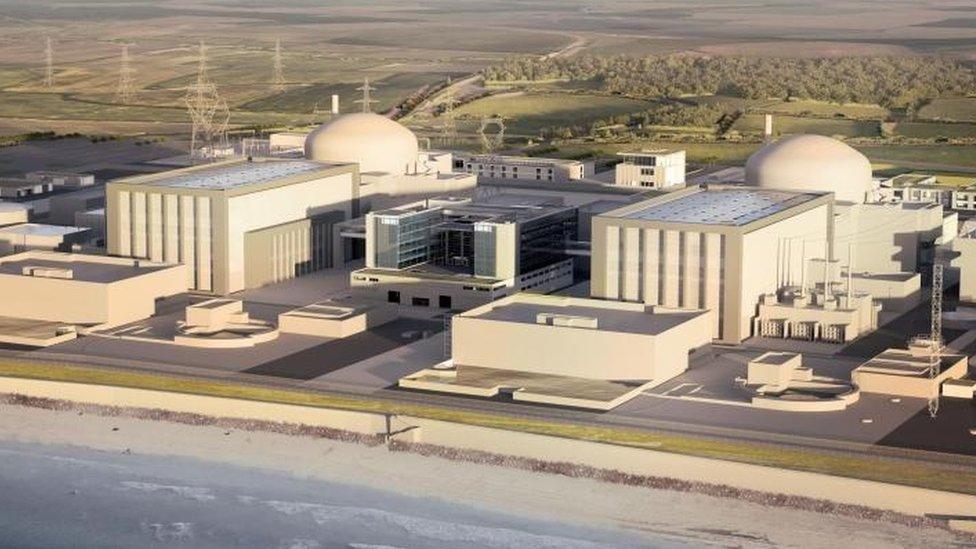Hinkley Point: Design difficulties loom
- Published

An artist's impression for EDF of how the new power station would look
Six years ago a French government inquiry issued a warning that makes for chilling and highly relevant reading even today.
The report said that the complexity of the kind of nuclear reactor destined for Hinkley Point was itself a "handicap" to its construction and its cost.
So it should come as no surprise that wherever the new European Pressurised Reactor (EPR) is being installed - in Finland, France and China - the projects are beset by delays and massive increases in price.
The EPR is what's called a Third Generation reactor and it's designed to be safer, more powerful and more efficient than earlier versions. Ironically, it's also meant to be easier to build. But so far the reality has been the opposite.
The first of the reactors was sold to a Finnish power company where, amid a blizzard of lawsuits, it's on course to be nine years late.
The second was ordered for an EDF site in Normandy where, as the BBC's Business Editor Simon Jack reports, it will be six years late. Two more are being assembled in China and are now estimated to be "only" two years late.
I put it to the engineers running the Hinkley project that a source of difficulty for the EPR could be all the new safety features - for example an extra layer of containment and a sophisticated device called a "core catcher" that sits below the reactor where it would trap any molten radioactive material if there was ever a meltdown.
No, came the answer. The new features are all manageable. The basic design is similar to the previous generation. We are very confident we can build it.
Pressure vessel
The problem is that, as the EDF Board prepares to make its final investment decision, there is not yet a single example that anyone can point to of the reactor actually working.
And its development has become something of a saga which not only involves huge questions about finance and politics but also about technology.
Simon Jack has highlighted the concerns about the forging of the reactor's housing - what's known the pressure vessel, a tower of steel that houses the actual process of nuclear fission.
This acts as the beating heart of the power station and, in the EPR's case, would help generate more power than was ever possible with earlier designs.
But tests last autumn rang an alarm bell.
They found that the dome capping the vessel installed at Flamanville in Normandy contained impurities - amid the steel there was a small zone with too much carbon.
This could potentially undermine the vessel's strength. The intense radiation generated within the reactor bombards the pressure vessel and, over the decades, makes the metal as brittle as glass.
Bizarrely, in a world of gleaming high technology, this area of excess carbon in the dome is referred to as a 'carrot' because of its shape.
Lessons 'have been learned'
This makes it sound rather innocent. In fact, it's forced a major pause. The dome in Normandy is now undergoing detailed investigations.
And the domes that had already been built for the first of Hinkley's reactors - one for the top of the vessel and one for the bottom - have been returned to their makers, the troubled French nuclear firm Areva.
Replacements have been ordered from a specialist Japanese steelmaker.
So will this add yet more delay to the project at Hinkley? No, we were told.
One line, above all, is being determinedly pushed: that lessons have been learned from Finland, Normandy and China.
Contractors are lined up. The 3D modelling has ironed out potential log-jams. The sequencing of concrete pouring and deliveries and electrical work and host of other jobs has been carefully choreographed.
And many of the engineers who lived through the challenges of the other EPR projects will be on hand at Hinkley. 'Veterans', as Simon Jack, calls them.
That could mean they have plenty of useful experience. Or they really know just how uncertain a task they face.
- Published30 March 2016

- Published22 March 2016
